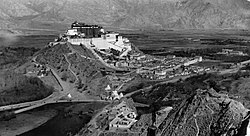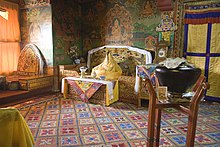Potala
The Potala or Lhasa Temple is the highest expression of Tibetan architecture and the residence of the Dalai Lama since Lozang Gyatso founded it in 1648 in Lhasa, the capital of Tibet. It was the home of the highest representatives of Buddhism until 1959, when Tenzin Gyatso, the fourteenth Dalai Lama, went into exile in Dharamsala (India) due to the popular revolt against China.
The monument is located on the so-called Red Hill, at a height of 3,650 meters above sea level. It reaches 400 m on its east-west axis and 350 m on its north-south axis, with sloping stone walls of an average thickness of three meters and five at the base and copper poured into the foundations to help protect it against earthquakes. It has thirteen-story buildings, with more than a thousand rooms, ten thousand sanctuaries and some two hundred thousand statues, which rise 117 m above the hill.
It was classified as a World Heritage Site by UNESCO in 1994. This declaration was expanded in 2000 and 2001, to include the neighboring monuments of Norbulingka Palace and Jokhang Temple. In 2017 it received more than 1.45 million visitors, 5.8% more than the previous period; Given the mass tourism, the local authorities decided to limit daily access to a maximum of five thousand people during the high season.
Location
Potala is characterized by its adaptation to the topography of the land thanks to its systems of terraced walls and stairs, as well as the vertical towers that are embedded in the mountain. For its construction, the top of Marpo Ri was chosen, the « Red Hill" of 117 m, which rises 3,650 meters above sea level and about 300 m above the Lhasa Valley. According to tradition, the three main hills of Lhasa represent the "three protectors of Tibet". Chokpori, just south of the palace, is the soul mountain (Wylie: bla ri) of Vajrapani, Pongwari that of Manjusri, and Marpo Ri, the hill on which the Potala stands, represents Avalokiteśvara. In the back of the building and in the shadow of the mountain is Zongjiao Lukang Park, a green area with ponds.
History
The origin of the building dates back to the year 631, when the Tibetan king Songtsan Gampo built a palace on the site after unifying the kingdoms of the plateau. Although the religious significance may have influenced the location, the palace was built on the mountain for military and strategic purposes. Two centuries later the complex was almost destroyed by lightning and a civil uprising. Later, in the year 877 and after the end of the Tibetan empire, the civil wars of the tribes in the area caused extensive damage and only two buildings were left standing. In the current Potala two chapels in the northeast corner of the enclosure preserve parts of these original constructions. One is the lhakhang Phakpa, and the other is Chogyel Drupuk, a cavern where Songtsen Gampo meditated.
The second palace —the one that remains today— was built in a context of the rise of power of the lamas. The Fifth Dalai Lama established his authority by founding the Potala, which served as the administrative and religious headquarters. Thus, the complex began to be built in 1645, after one of the Dalai Lama's spiritual advisers, Konchog Chophel, pointed out that it was the ideal place for his base of government, since it was located between the Drepung and Monasteries. Sera and the ancient city of Lhasa. The outer structure was completed in three years, while the interior, along with all the furnishings, took another forty-five years to complete. The Buddhist leader and his government moved to the White Palace (Potrang Karpo) in 1649. Work on the Potala continued until 1694, twelve years after his death. Back then, it was used as a winter residence for the Dalai Lama. The Red Palace (Potrang Marpo) was added between 1690 and 1694. A renovation of the complex took place in 1922 under the thirteenth Buddhist leader.
After the Chinese occupation of Tibet
The palace was moderately damaged during the 1959 Tibetan uprising, when Chinese shells were thrown at the windows. Before the People's Liberation Army shot and took Jampa Kalden prisoner, he testified: "the cannon shells The Chinese began to rain down on Norbulingka last midnight on March 19, 1959...The sky lit up when they targeted the Chakpori medical college and the Potala". He escaped further damage during the 1966 Cultural Revolution through intervention staff of Zhou Enlai, the then Premier of the People's Republic of China. According to Tibetan historian Tsering Woeser, the palace housed "more than 100,000 volumes of historical writings and documents" as well as "warehouses housing precious objects, handicrafts, paintings, tapestries, statues, and ancient armor," and was "almost completely stolen".
Since 1994, Potala has been on the UNESCO World Heritage List. In 2000 and 2001, Jokhang Temple and Norbulingka were added as extensions under the name "Potala Palace Historical Complex". The modernization of its surroundings was a concern for Unesco, which expressed that the construction of contemporary buildings could threaten the unique atmosphere of the palace, as well as the occupation of shops and businesses in its vicinity. In response, the Chinese government issued a rule prohibiting the construction of any structure taller than 21 meters in the area. The international organization also expressed doubts about the materials used during the restoration of the palace, which began in 2002 at a cost of 180 million yuan (approximately 22.5 million US dollars). Potala director Qiangba Gesang said they only used traditional components and handicrafts. The complex also received rehabilitation works between 1989 and 1994, the budget of which rose to 55 million yuan (about 6.875 million dollars).
Architecture
Construction of the palace began in 1645 on the ruins of a previous fortification. It has dimensions of 400 meters long and 350 wide. The complex was conceived to adapt to the topography of the mountain through a system of walls and terraced stairs. The base walls are up to 5 meters thick and the stone used is mixed with molten copper to strengthen it in the event of an earthquake. The palace complex is made up of two main sections, in addition to the complementary buildings: the White Palace and the Red Palace, whose names recall the color of the pigment that covers them. Every autumn they receive a new layer of paint based on milk, honey and sugar. The main structure is made up of thirteen floors distributed in 115 m height.
The White Palace
The White Palace or Potrang Karpo is the residence of the Dalai Lama. Construction began during the rule of the fifth Tibetan leader, when he moved here with his government in 1649. In the early 20th century, reached its current dimensions thanks to the reform carried out by the thirteenth Dalai Lama. The palace has always had secular uses, and includes rooms, offices, a seminary, and a printing house. A yellow-painted central courtyard, known as the Deyangshar, separates the quarters of the chief executive and his monks from the Red Palace, the part of the Potala devoted entirely to study and prayer. This houses the eighth Dalai Lama's golden stupa, the hall of monastic assemblies, numerous chapels and sanctuaries, and libraries with important Buddhist writings, such as the Kangyur, with 108 volumes, or the Tengyur, with 225 manufactured in gold ink The yellow building next to the White Palace houses the large flags with holy symbols that are hung on the southern façade during New Year's festivals.
The Red Palace
The Red Palace (Potrang Marpo) was built in 1694 under the Sixth Dalai Lama. Unlike the White Palace, this complex had a religious function and was used for the study of Buddhism. The structure of the set is based on an Indian design in the form of a mandala. The seven gilt bronze roofs that make up the Dalai Lama stupas surround the palace. The needles that finish off these points are composed of ornaments in the shape of flowers and bells, which in turn serve as lightning rods.
Tourism
Tourism is one of Tibet's economic pillars, and Potala is its most notable and popular destination. The monument only admitted 1,500 visitors a day until 2006, when the Qinghai–Tibet Railway opened to the public on 1 July and the margin was extended to 2,300. In 2015, the palace hosted some 900,000 tourists; in 2017 it reached 1.45 million, which was 5.8% more than last year. With the arrival of the COVID-19 pandemic, in 2020 visitors to the complex increased by 12.6% compared to the previous period thanks to national tourists Chinese. Faced with the wave of foreigners in the palace, local administrators found themselves in the position of "balancing tourist demand with the need to minimize wear and tear on the enormous structure." Consequently, a maximum of five thousand daily visitors was limited during high season and with a stipulated fixed schedule. In sessions where more people attend than this limit, an alternative route is enabled that does not include the Red Palace, since "it is built with wood and clay, which cannot support too many visitors a day".
The main attraction of the Potala, and of Tibet in general, is the mysticism that surrounds it and its remote location among snow-capped mountains. For Chinese visitors, the region has significant natural landscapes. Thus, given the rise of the middle class in the country, Tibetan tourism has changed its focus from attracting foreigners to nationals. As a consequence, locals have come to claim that "Chinese tourists do not respect cultural traditions". Lhasa police arrest dozens of scalpers, whose business is favored by the limit of tickets issued daily and the need to to reserve them in advance.





